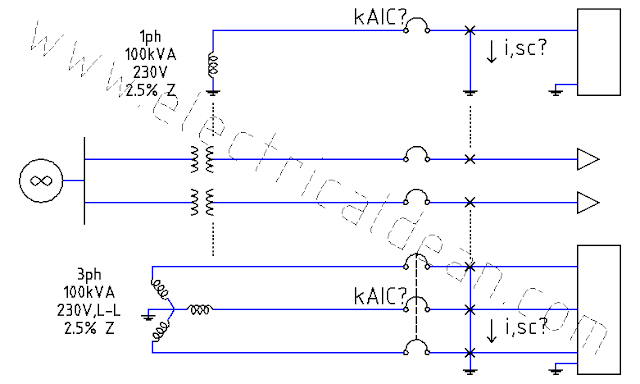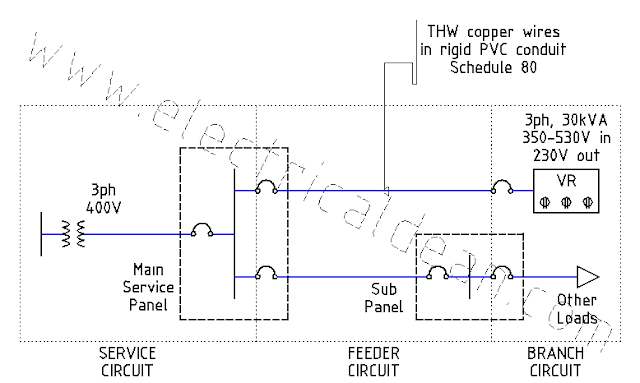Generation - Scenario 3
Consider the generator from the previous scenario, but without any loads attached. This post examines what will happen to its internal EMF at no-load condition.
SITUATION
A compound DC generator rated 20 kiloWatts, with resistances in its armature winding at 0.05 ohm, series field winding at 0.025 ohm, and shunt field winding at 100 ohms, operates at NO LOAD with 250 Volts at its terminals.
With the machine configured as short shunt, what is the internal electromotive force produced by the generator?
ANALYSIS
1.) Schematic diagram, short shunt compound:
2.) One-line diagram:
3.) Power drawn by load: P,L = 0 (NO LOAD)
4.) Voltage at the generator terminals: V,t = 250V
5.) Resistances
5.1.) Armature winding resistance: R,ar = 0.05 ohm
5.2.) Series field winding resistance: R,se = 0.025 ohm
5.3.) Shunt field winding resistance: R,sh = 100 ohms
6.) Short shunt configuration
6.1.) With NO LOAD, there is no series field current: i,se = 0
6.2.) Shunt field voltage, NO-LOAD loop:
-V,sh + i,se * R,se + V,t = 0
V,sh = 0 * 0.025 + 250
V,sh = 250V
6.3.) Shunt field current:
i,sh = V,sh / R,sh
i,sh = 250V / 100 ohms
i,sh = 2.5A
6.4.) Armature current:
i,ar = i,sh + i,se
i,ar = 2.5 + 0
i,ar = 2.5A
6.5.) Internal electromotive force:
-EMF + i,ar * R,ar + V,sh = 0
EMF = 2.5 * 0.05 + 250
EMF = 250.125V
CONCLUSION
This short shunt compound DC generator produces 250.125 Volts of internal EMF to operate at 250V terminal voltage with NO LOAD.
For further comparison, this next scenario examines the generator's internal EMF again, this time at half-load condition.
SITUATION
A compound DC generator rated 20 kiloWatts, with resistances in its armature winding at 0.05 ohm, series field winding at 0.025 ohm, and shunt field winding at 100 ohms, operates at NO LOAD with 250 Volts at its terminals.
With the machine configured as short shunt, what is the internal electromotive force produced by the generator?
ANALYSIS
1.) Schematic diagram, short shunt compound:
2.) One-line diagram:
o|---EMF---R,ar---|---R,se---V,t---x
|
R,sh
|
v
3.) Power drawn by load: P,L = 0 (NO LOAD)
4.) Voltage at the generator terminals: V,t = 250V
5.) Resistances
5.1.) Armature winding resistance: R,ar = 0.05 ohm
5.2.) Series field winding resistance: R,se = 0.025 ohm
5.3.) Shunt field winding resistance: R,sh = 100 ohms
6.) Short shunt configuration
6.1.) With NO LOAD, there is no series field current: i,se = 0
6.2.) Shunt field voltage, NO-LOAD loop:
-V,sh + i,se * R,se + V,t = 0
V,sh = 0 * 0.025 + 250
V,sh = 250V
6.3.) Shunt field current:
i,sh = V,sh / R,sh
i,sh = 250V / 100 ohms
i,sh = 2.5A
6.4.) Armature current:
i,ar = i,sh + i,se
i,ar = 2.5 + 0
i,ar = 2.5A
6.5.) Internal electromotive force:
-EMF + i,ar * R,ar + V,sh = 0
EMF = 2.5 * 0.05 + 250
EMF = 250.125V
CONCLUSION
This short shunt compound DC generator produces 250.125 Volts of internal EMF to operate at 250V terminal voltage with NO LOAD.
For further comparison, this next scenario examines the generator's internal EMF again, this time at half-load condition.





Comments
Post a Comment